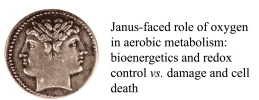By: Helmut Sies
Published in the journal Redox Biology. Click here to view the full article.
 “Oxidative stress” as a concept in redox biology and medicine has been formulated in 1985; at the beginning of 2015, approx. 138,000 PubMed entries show for this term. This concept has its merits and its pitfalls. Among the merits is the notion, elicited by the combined two terms of (i) aerobic metabolism as a steady-state redox balance and (ii) the associated potential strains in the balance as denoted by the term, stress, evoking biological stress responses. Current research on molecular redox switches governing oxidative stress responses is in full bloom.
“Oxidative stress” as a concept in redox biology and medicine has been formulated in 1985; at the beginning of 2015, approx. 138,000 PubMed entries show for this term. This concept has its merits and its pitfalls. Among the merits is the notion, elicited by the combined two terms of (i) aerobic metabolism as a steady-state redox balance and (ii) the associated potential strains in the balance as denoted by the term, stress, evoking biological stress responses. Current research on molecular redox switches governing oxidative stress responses is in full bloom.
The fundamental importance of linking redox shifts to phosphorylation/dephosphorylation signaling is being more fully appreciated, thanks to major advances in methodology. Among the pitfalls is the fact that the underlying molecular details are to be worked out in each particular case, which is bvious for a global concept, but which is sometimes overlooked. This can lead to indiscriminate use of the term, oxidative stress, without clear relation to redox chemistry. The major role in antioxidant defense is fulfilled by antioxidant enzymes, not by small-molecule antioxidant compounds. The field of oxidative stress research embraces chemistry, biochemistry, cell biology, physiology and pathophysiology, all the way to medicine and health and disease research.
— Published
Category: Redox Biology